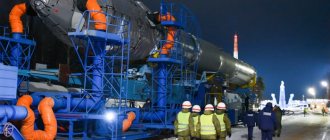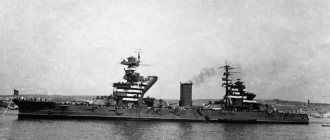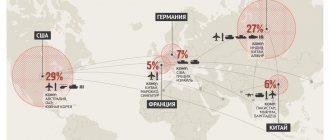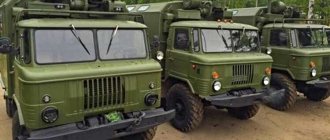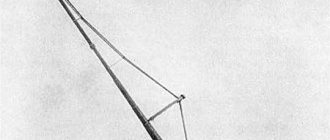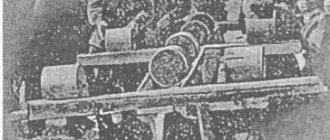The conflict between India and Pakistan continues to flare up. On Wednesday, February 27, there were reports that an air battle had taken place over the Line of Control in Kashmir. The Indian Foreign Ministry said that the country's air force shot down one Pakistani fighter and lost one of its own aircraft. In turn, Pakistani authorities claim that two Indian planes were shot down and two Indian pilots were detained.
Related article No peace for Kashmir. Does India want war with Pakistan?
Relations between the countries worsened on February 14 after a terrorist attack occurred in the Indian state of Jammu and Kashmir, which killed 45 people. The Jaish-e-Muhammad group (banned in Russia) took responsibility for it. After this, India accused Pakistan of supporting terrorism and on February 26 attacked a terrorist group camp in the Pakistani-controlled part of Kashmir (this territory is disputed by India and Pakistan). The air battle on February 27 became the next round of the flaring conflict.
AiF.ru provides information on the composition of the armed forces and the amount of military equipment in India and Pakistan.
general information
The Army of the Islamic Republic of Pakistan was created to protect its sovereignty from external enemies and is seen as a serious force in the region and in the domestic political arena. It was formed in 1947, when, as a result of the collapse of the British Empire, its overseas possessions received the right to self-determination. It was during this period that Pakistan seceded from India and declared itself an independent state. In Delhi, this fact is still disputed.
During its existence, the army of the Islamic Republic confronted the Indian armed forces four times and once participated in the conflict with Afghanistan. Limited army contingents (at the invitation of the governments of some Arab states) helped them during numerous conflicts with Israel. Later, several divisions took part in the 1st Gulf War. But this time Pakistan sided with the pro-American coalition.
Today, the armed forces of the republic are actively engaged in ousting Taliban forces from the northwestern regions.
The Pakistani army is also involved in peacekeeping operations conducted under the auspices of the UN, although its contingent is not very large.
The president of the country is considered the supreme commander in chief.
As follows from the constitution of the republic, the army is subject to the decisions of the federal government and stands to protect Pakistan from external threats. The armed forces must also provide assistance to civilian authorities, but only within the limits established by law.
Notes
- The Military Balance 2022. - P. 291.
- Book shines light on Pakistan military's '£10bn empire'. Access date: August 28, 2010. Archived April 27, 2012.
- PAKISTAN (English) (unavailable link). Access date: August 28, 2010. Archived February 10, 1998.
- ↑ 123456
Special Service Group (Army) (English) (inaccessible link). Access date: August 30, 2010. Archived March 11, 2012. - ↑ 1 2 3 Borisov T. I., Denisentsev S. A., Kashin V. B and others.
Pakistan beyond stereotypes. — Popular science. - M.: AST-Center, 2022. - P. 129. - 207 p. — 500 copies. — ISBN 978-5-9909882-5-5. - "Subdivisions of the army" (undefined)
(inaccessible link). Access date: August 28, 2010. Archived November 16, 2006. - ↑ 123456
Fighting & Supporting Arms - ↑ 12345678910111213141516171819202122232425262728293031323334353637383940414243444546474849505152535455565758596061
The Military Balance, 2022, p. 300. - SH1 (English). Access date: August 28, 2010. Archived March 11, 2012.
Acquisition principles
The Pakistani armed forces are formed entirely on a voluntary basis and almost exclusively by male citizens at least 17 years of age. With the beginning of the new century, women also began to enter the service, but there are still very few of them. Representatives of the fairer sex in the troops are very atypical for a Muslim country.
Every year in Pakistan just under 2,200,000 men and 2,000,000 women reach the age of service.
The total reserve (persons from 16 to 49 years old) is 92,000,000. Of these, however, only 70,000,000 are actually capable of performing military service.
The country devotes 3 percent of its GDP every year to military needs.
Market relations
In general, despite the stereotypes that exist in society that Pakistan is not the safest country to travel, I did not find any evidence to support this opinion.
Almost everywhere I was greeted with cordiality, hospitality and undisguised interest, as befits peace-loving peoples. Otherwise, apart from the influence of religion, life in Pakistan is not so different from life in other countries in the Asian region. Most people live a difficult life, earning their living through hard physical labor. In villages this is mainly agriculture. In large cities, trade in everything possible is thriving - from cheap goods to real works of art.
Pakistani markets and bazaars are a different story. I remember how impressed I was by an ordinary banana seller at a market in Islamabad. His white shalwar kameez, the national dress common in Pakistan, was unusually clean and softly outlined the smooth curves of his figure, his small rounded tummy. On his head was a tall turban made of the same snow-white fabric. Somewhat short, rounded fingers were decorated with bright rings with large stones, the look was relaxed and calm
While waiting for customers, he slowly drank masala tea from a small porcelain cup, carefully holding it by the graceful handle with two fingers, and, after taking another sip, placed it on the saucer. His appearance, which was so different from my ideas about people selling at bazaars, was in the order of things here. And the market itself looked more like a whole shopping area. In one block there are shops that sell one product - for example, fabrics or clothing, then they offer carpets to visitors, then food. It feels like half the country's population is buying or selling something.
In the city they offer everything possible - from food to clothing, carpets, household appliances and jewelry, while outside the city the primacy is given to livestock markets. Each type of animal is given a separate field: in one corner they sell goats of various breeds and colors with intricately curved horns, in the other, the pride of the sellers - stud bulls - is presented on powerful banners.
Photo: Alexey Terentyev
Some animals have such a warlike disposition that only the owner dares to approach them, while each animal is restrained by a metal chain threaded through its nostril. You can walk around this market all day, and it is equally interesting to watch both animals and people. And if you are tired, you can go under the canopy where food is prepared. In between auctions, sellers come here to have a snack, relax and drink aromatic tea, slowly sipping it from a saucer - a tradition that is so close to us, Russians.
Formation of the army - history
The initial stage of building Pakistan's own armed forces lasted from 1947 to 1958. After the collapse of British imperialism, the newly created state received infantry (8) and artillery (8) regiments, as well as 6 tank regiments. India at that time had 21, 40 and 12, respectively.
The Pakistani government was afraid that Delhi would try to occupy Kashmir, because in this state there was a civil confrontation in which irregular militias and individual tribes tried to overthrow the local maharaja. As a result of intervention in a local conflict, the first Indian-Pakistani war broke out. The fighting, however, quickly stopped, since Frank Messervy (British), the chief of staff of the PVA, who was responsible for the operation, did not want to carry out what seemed to him to be the criminal orders of the country’s leader. During a period of calm, the UN intervened in the conflict. As a result, Kashmir was divided between opponents (the northwestern part of the region was given to Pakistan).
A sharp strengthening of the army of the Islamic Republic occurred in 1950. It was then given considerable resources, freed up as a result of the conclusion of a mutual defense agreement between Washington and London.
In 1954, Pakistan entered into an agreement with the United States to provide military assistance to the latter. At the same time, the country said goodbye to its non-aligned status and became a member of the Baghdad Pact. The latter, after some time, was renamed the Central Treaty Organization.
Weapons and military equipment
Main article: List of weapons and military equipment of the Pakistan Army
| Type | Image | Production | Purpose | Quantity | Notes |
| Tanks | |||||
| Al-Khalid Al-Khalid I | China/Pakistan | Main battle tank | 300[8] 50[8] | ||
| T-80UD | USSR | Main battle tank | 315[8] | ||
| Al-Zarrar | China/Pakistan | Main battle tank | 500[8] | ||
| Type 85-IIAP | China | Main battle tank | 268[8] | ||
| Type 69 | China | Main battle tank | 400[8] | ||
| ZTZ-59 | China | Main battle tank | 600[8] | ||
| Armored fighting vehicles | |||||
| M113A1/A2/P Talha VCC-1/VCC-2 | USA Pakistan Italy | Armored personnel carrier | 2300[8] 200[8] 600[8] | ||
| ZSD-63 | Armored personnel carrier | 100[8] | |||
| BTR-70 | USSR | Armored personnel carrier | 100[8] | ||
| BTR-80 | USSR | Armored personnel carrier | |||
| Maxxpro | USA | MRAP armored vehicle | 255[8] | ||
| Dingo 2 | Germany | Armored car | 10[8] | ||
| Artillery | |||||
| M109A2 M109A5 M109L | USA USA Italy | 155 mm self-propelled howitzer | 200[8] 115[8] 123[8] | ||
| SH1 | China | 155 mm self-propelled howitzer | 90[9] | ||
| M110/M110A2 | USA | 203 mm self-propelled howitzer | 60[8] | ||
| M101 | USA | 105 mm towed howitzer | 216[8] | ||
| OTO Melara Mod 56 | Italy | 105 mm towed howitzer | 113[8] | ||
| D-30 | China | 122 mm towed howitzer | 80[8] | ||
| Type 54 | China | 122 mm towed howitzer | 490[8] | ||
| Type-59-I | China | 130 mm towed gun | 410[8] | ||
| M114 | USA | 155 mm towed howitzer | 144[8] | ||
| M198 | USA | 155 mm towed howitzer | 148[8] | ||
| Panther | Türkiye/Pakistan | 155 mm towed howitzer | 30+[8] | ||
| M115 | USA | 203 mm towed howitzer | 28[8] | ||
| Type 81 SPMRL | China | 107 mm multiple launch rocket system | n/a[8] | ||
| Azar | Pakistan | 122 mm multiple launch rocket system | 52[8] | ||
| KRL-122 | Photo | Pakistan | 122 mm multiple launch rocket system | n/a[8] | |
| A-100 | 300 mm multiple launch rocket system | 36[8] | |||
| Ballistic missiles | |||||
| Ghauri Ghauri II | Pakistan | Medium-range ballistic missile | 30[8] | ||
| Shaheen-2 | Pakistan | Medium-range ballistic missile | n/a[8] | ||
| Ghaznavi (Shaheen-1) | Pakistan | Short range ballistic missile | 30[8] | ||
| Abdali | Pakistan | Short range ballistic missile | n/a[8] | ||
| Hatf-1 | Pakistan | Tactical missile | 105[8] | ||
| Babur | Pakistan | Cruise missile | n/a[8] | ||
| Anti-tank weapons | |||||
| M901-TOW | USA | Self-propelled anti-tank missile system | n/a[8] | ||
| Maaz | Pakistan | Self-propelled anti-tank missile system | 30[8] | HJ-8 ATGM on Talha armored personnel carrier chassis | |
| Type 52 | China | 75 mm recoilless rifle | n/a[8] | ||
| M40A1 | USA | 106 mm recoilless rifle | n/a[8] | ||
| Type 56 | China | anti-tank gun | 200[8] | ||
| Army aviation | |||||
| AH-1F/S Cobra | USA | Attack helicopter | 38[8] | ||
| Mi-35M | Russia | Attack helicopter | 4[8] | ||
| Mi-17 Mi-171E | Russia | Transport helicopter | 38+[8] 2[8] | ||
| Mi-171 Mi-172 | Russia | Transport helicopter | 4[8] 1[8] | ||
| SA330 Puma | France | Transport helicopter | 31[8] | ||
| AW139 | Italy | Multi-role helicopter | 7[8] | ||
| Bell 206B Jet Ranger II | USA | Multi-role helicopter | 13[8] | ||
| Bell 205 Bell 205A-1 (AB-205A-1) | USA | Multi-role helicopter | 5[8] 5[8] | ||
| Bell 412EP Twin Huey | USA | Multi-role helicopter | 26[8] | ||
| SA319 Alouette III | France | Multi-role helicopter | 20[8] | ||
| SA315B Lama | France | Multi-role helicopter | 12[8] | ||
| H125M Fennec | France | Multi-role helicopter | 10[8] | ||
| H125 Ecureuil | France | Multi-role helicopter | [8] | ||
| Beechcraft King Air 350 | USA | Light general purpose aircraft | 1 | ||
| Cessna 208B Grand Caravan | USA | Light general purpose aircraft | 1 | ||
| Jasoos | Pakistan | Unmanned aerial vehicle | n/a[8] | ||
| Jasoos II Bravo | Pakistan | Unmanned aerial vehicle | n/a[8] | ||
| Vector | Pakistan | Unmanned aerial vehicle | n/a[8] | ||
Second phase
In 1958, the army carried out its first coup, which resulted in the transfer of all power to General Ayub Khan.
All this happened against the backdrop of ongoing tension on the Pakistani-Indian border - low-intensity firefights continued here, but the parties tried to remain in their positions. In 1965, Pakistan attempts to completely take over Kashmir. Conceived as a lightning-fast Operation Gibraltar, it eventually resulted in a full-fledged war. Large-scale battles lasted, however, only 3 weeks, as the UN intervened again. Ultimately, in Tashkent the parties signed a special declaration on the restoration of the pre-war border.
Air!
But now it’s gloom and confusion on the Indian side. Numerous well-deserved MiG-21s are now outdated not only morally, but also physically. This was superimposed on the “wonderful” Indian ability to conduct tenders for the purchase of aircraft, as a result of which no new aircraft were added. Now everything looks very motley. The basis is more than 250 Su-30MKIs; in the event of air battles, the main Indian bet is on them. Then everything is crumpled. In small “scraps” there are MiG-29, French “mirages”, several relatives, suffered by the Indians through the full “Tejas”, as well as MiG-21 and MiG-27, whose life in this earthly incarnation has clearly come to an end.
In reality, India can field hundreds of three vehicles capable of modern air combat. Everything else is more suitable for operations against an enemy who does not have normal air defense.
Pakistan has a simpler situation in this regard. Several dozen American F-16s purchased here and there on occasion, “mirages” of various modifications, many of which are already at retirement age, and a slowly growing future core - the Chinese Chengdu JF-17 (a joint Chinese-Pakistani fighter-bomber , which has a very distant relative the Soviet MiG-21). It is expected to increase their number to two and a half hundred, but this is still far away.
While the Pakistanis clearly have fewer vehicles, in the event of isolated air skirmishes they can cause the Indians a lot of trouble. Separately, it is worth mentioning the S-400 Triumph anti-aircraft missile systems India is buying from Russia, and they are capable of greatly changing the celestial alignment. However, according to the plan, deliveries will begin only at the end of 2022.
Period from 1969 to present time
In 1969, Ayub Khan was overthrown and Yahya Khan took his place. This leader provided patronage to the western part of Pakistan to the detriment of the eastern regions. The resulting political and economic inequality led to the uprising.
Attempts to restore order in the eastern provinces with the help of the army led nowhere. India took advantage of the opportunity and invaded there in 1971. As a result, local government officials and troops in the region (totaling 90,000) capitulated. After this, the independent state of Bangladesh was created in the eastern lands.
In December 1971, Zulfiqar Bhutto replaced Yahya Khan as president (after a coup, of course). He gave his comrade Zia-ul-Haq the post of chief of staff of the ground forces.
In 1977, another coup took place and Muhammad Zia-ul-Haq became the leader of Pakistan. He hanged Bhutto and initially promised the people democratic elections in 3 months, but then changed his mind and remained in the position of a de facto dictator. The political situation changed only after the death of Zia-ul-Haq (this happened in 1988).
In 1975, the armed forces had to suppress the uprising in Baluchistan - this part of the country tried to isolate itself, but the federal center did not even want to give autonomy. Clashes with the partisans continued for several years until Zia-ul-Haq took power and dealt with the rebels.
In 1979, the Pakistani army actively assisted the Saudi authorities in liberating the Islamic shrine of the Kaaba from terrorists. The previously invited French special forces provided her with full assistance in this.
The last military coup in Pakistan took place in 1999. Pervez Musharraf came to power instead of the previously elected government. He served as president until 2008. A year later, the country's supreme court overturned the dictator's state of emergency.
The latter’s long reign can be explained simply – Musharraf actively collaborated with the United States. In particular, at Washington’s request, he sent 72,000 army personnel to participate in the war against the Taliban that began in 2001. However, the troops were in no hurry to advance, and military operations – until 2009 – remained purely positional. Only in that year was an offensive launched, which resulted in the liberation of South Waziristan.
Today, the Pakistani armed forces are preparing to finally liberate the country from the Taliban.
Roadside flavor
A few days later, my acquaintance with the capital was over, and I was expected to dive into the provinces of Pakistan. While driving along the Karakoram Highway, at every turn the country revealed itself to me with small scenes from the lives of ordinary people. Here comes a man with fiery hair - by the way, both men and women dye their hair here, and most often the most affordable natural henna is used as a dye. On another section of the road I see how in a small village they bake bread in a tandoor. The oven is laid directly in the ground, under a small canopy; a local resident, with deft movements, attaches dough cakes directly to the vertical walls, and after a few minutes takes out the ready-made bread.
Around the next turn, a flat area cleared of stones appears, on which about twenty men perform namaz. The construction of a mosque is not accessible to all villages, and prayers need to be performed every day, so in some villages for these purposes they use specially cleared areas among the mountains, right in the open air. In another settlement, we met a local doctor who treats with herbs and diagnoses by pulse; he tells us about the principles underlying Ayurvedic and Tibetan medicine, according to which a person is treated as a whole, and not divided into separate organs. There is the influence of India, which is just a stone's throw from here.
Photo: Alexey Terentyev
Having already become familiar with my habit of rushing with a camera and asking questions to the first person I met, upon entering Hunza my guide and driver could finally relax. “The people here are completely different,” he explained his behavior. In other parts of the country, reactions to both a camera and a stranger can be very different, but in Hunza you can always count on exceptionally warm treatment and feel safe.
This is due to different understandings of Islam in different regions of the country. In Hunza, people have a special view of religion. While remaining deeply religious, they are not as radical as representatives of other movements, they do not hide their faces, they are always happy to invite you to visit, women can be photographed and communicate on an equal basis with men.
Here, unlike other regions of the country, there are practically no cases of aggression or violence. At the very first stop, I fully felt the difference, when women, men and girls surrounded me with interest, invited me into the house, ready to support communication. By the way, in most other places such initiative most often comes from men, and communication with representatives of the opposite sex is more or less free only in Islamabad and its environs.
As soon as I set foot on the land of Hunza, I saw the first and probably key difference between the local residents and their neighbors: a slightly different understanding of religion made these people more open and good-natured, and the atmosphere in which they live warmer and more loving
Hunza has long lost the status of the mysterious Shangri-La that it once had. An excellent expressway runs through the valley, connecting the country with China and built by it. However, this place has not lost its charm. Majestic mountains with snow-covered peaks, glaciers shimmering in the sun and the sound of mountain rivers, the beauty of apricot gardens blooming in spring, which the famous Japanese sakura will envy - all this still attracts lovers of mountains, fresh air and breathtaking landscapes.
Several hotels have been built in both Karimabad and Upper Hunza, some of them very comfortable. And although there are still few tourists here, hotels are usually not empty during the season. At the same time, it cannot be said that the life of ordinary people has changed much during this time - as a rule, it is still the same hard work that allowed their ancestors to survive in these places. I was especially struck by the barrier made of stones laid by the residents of one village: it turned out that it needs to be renewed every year, and this difficult work is still done almost by hand. It is also impossible not to make a barrier, since otherwise mudflows and rockfalls will simply destroy the small village.



